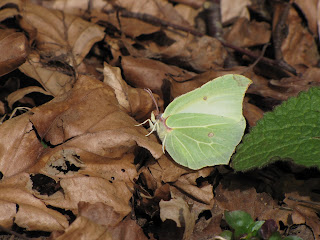At Weston Common (near Lasham) there were record numbers of singing Tree Pipits - with 13 singing males found there on 18 April. (This compares to 7 last year). Some of these are in the area of clearfell where the Southern Beech has been cleared. Others are in the young deciduous plantation. The fence which borders this has always been a regular place to see Green Woodpeckers. It is now clear that they are actually feeding on grubs within the fence posts. As can be seen in this photo, the posts are now suffering...
The warm weather has brought out many butterflies. Holly Blues seem to be in particularly high numbers. This Brimstone at Weston Common picked up a hitchhiker.
There are now good numbers of female Brimstones - the initial emergence comprised mainly males. Also on the wing now are Speckled Wood, Small White
Plenty of hoverflies too: I believe this is Eupiodes latifasciatus.
Weston Common is a reliable place for Fallow Deer - note the distinctive white horseshoe on the hind parts. Fallow Deer tend to see in larger groups while the commoner Roe Deer is normally in groups of 1-3. I have never seen a Fallow Deer as far south as Alton - yet there are plenty to the north of Shalden. The story goes that these are the descendants of the Hackwood House (Basingstoke) herd which escaped by walking over the top of the wall in the huge snows of 1962.
This oak near Dummer had a large number of galls:
Ladies Smock (or Cuckoo Flower) near Alton: the insects seem to be flies of some sort.
Both the River Wey and the Caker Stream hold interesting wildlife as they flow through Alton's Industrial Estates. Marsh Marigold:
Grey Wagtail along the Wey in Alton:
A number of this brood of Mallard ducklings have white breasts - which matches the mother. I wonder whether this a trait of the female line. A similar brood was one of the first broods to hatch at Kings Pond last year. These were along the Caker Stream at Waterbrook Industrial Estate and I suspect are related.
Another brood of Mallards along the Caker Stream:
Finally - a bit further afield. Migration is not just about birds. I saw this bat - perhaps a pipistrelle species - arrive in off the sea at Sandy Point, Hayling Island on a misty/drizzly morning on Tuesday. It immediately landed on the sea-defence rocks and crawled down. Interestingly another bat sp. was seen arriving off the sea at Portland on 19 April.












